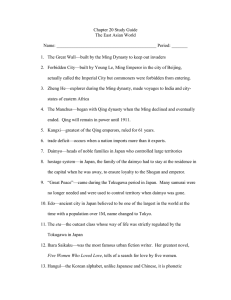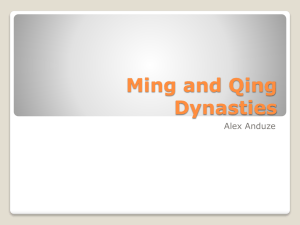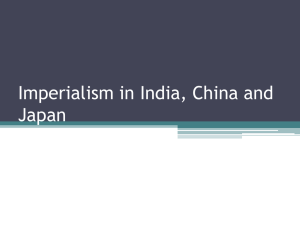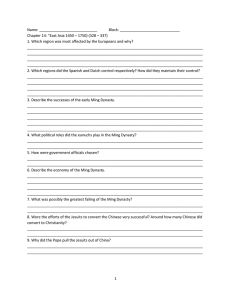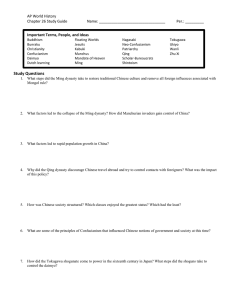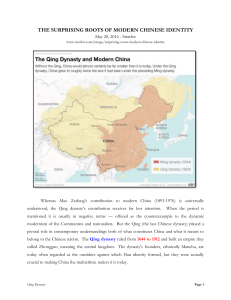Ming to Qing Dynasty
advertisement
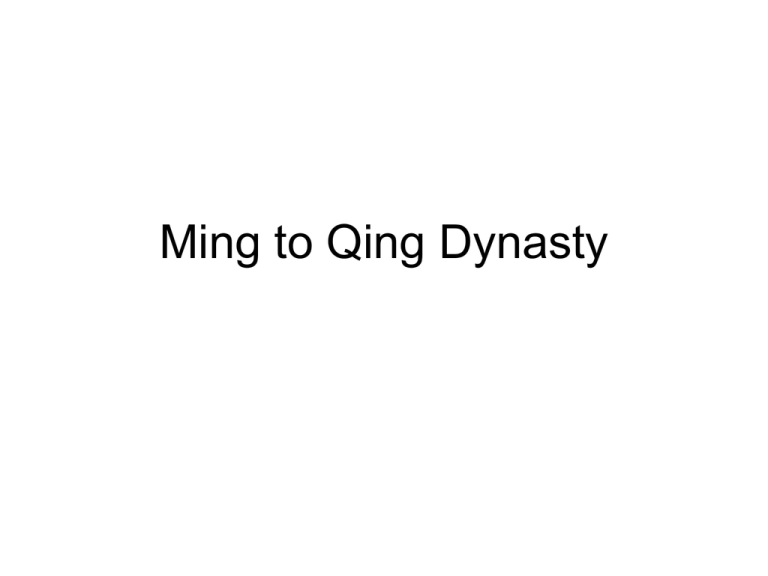
Ming to Qing Dynasty Agenda 1. Bell Ringer: Who is the best/worst ruler of the Mughal Dynasty? Provide evidence for your answer. 2. Lecture: Ming and Qing Dynasty 3. CCoT Essay Breakdown, Analysis 4. Primary Source: Christian vs Confucianism 5. Primary Source: Sacred Edict of Kangxi. 6. An Act of War? HW: Scientific Revolution DBQ in eight days. Objective: Students will analyze and correctly interpret documents pertaining to Ming and Qing China. Students will examine the influence of Christianity on the Qing Dynasty. The Mongols are gone!! • Hongwu takes power in 1368, rebel warlord that started as a peasant. • Copied Yuan military system • Militaristic – Prime Minister beheaded for plotting against him. – Then they killed his entire family (40,000) • Centralized government – He would review each document individually. Ming to the Qing: Outside Contact • Initially, minor trade occurred through the silk road and maritime routes around India. • Christian Missionaries are allowed into China around 1580-1600. (Jesuits) • There was an attempt to correlate Christian Teachings with Confucianism to develop a relationship between East and West. Ming Decline • Many Westerners looked at the area with pride and curiosity. • However, decline began with weak rulers at this time. – Too much structure led to antiquated policies. • Inflation was rampant because of foreign silver. • Then the English and Dutch begin disrupting silver trade. • Little Ice Age- Leads to crops failing, starvation. Manchus take over, Qing Dynasty (1644-1911) • Just like the Mongols in 1279, the Manchus invade in an era of revolt and starvation. • Very strict – All Chinese forced to adopt Manchu dress and customs. – Still utilized Confucian edicts. • Intermarriage prohibited • Strong rulers dominate early in the Qing Dynasty, and opium and western influence would lead to its downfall. Kangxi • Gained the throne at the age of 7 • Pacified traditional Chinese to accept Manchu culture. • Very tolerant of Christianity, but Christians were less tolerant of beliefs. – The Church would not agree on accommodating local beliefs and practices. • Christian activities suppressed after his death. Qianlong • Used strong military against tribes of the north. • Promoted economic prosperity and administrative efficiency. • Downfall of the Qing Dynasty begins at this point. – Corruption by Heshen, funds diverted from treasury CCoT Breakdown 1. Thesis 2. Continuity/Change 3. Evidence (6) 4. World Historical Context 5. Analysis • • • • 1 2 2 1 • 1


